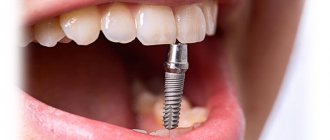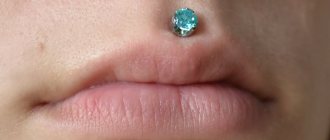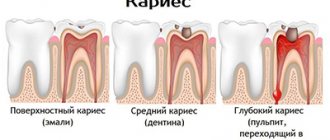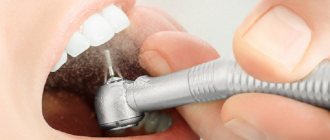Every person goes to the dentist at least once in his life. An unbalanced diet, genetic predisposition, lack of minerals, lack of proper hygiene, smoking and other factors negatively affect the condition of teeth, leading to rapid destruction of enamel and the appearance of caries. Only timely treatment will preserve oral health and a beautiful smile. The most common option for dental care is placing a filling on a damaged tooth. What are the materials and how is the procedure?
Tooth preparation
Not everyone knows for sure how teeth are filled. Does it hurt? Even 20 years ago, such an event was extremely unpleasant, especially in cases where the doctor removed the nerve. Now everything has changed. Let's take a look at the terminology used by modern doctors. Preparing is the same as drilling a tooth. The doctor uses a drill to remove areas damaged by caries. The procedure is carried out before filling.
You may be interested in:Dental milling cutters: types of tools, production methods
It happens that preparation and filling cannot solve the problem if the tooth is so badly damaged, for example, with pulpitis, that the small volume of healthy tissue simply cannot withstand the load. In such cases, you have to resort to installing a crown. But before that, the doctor fills the canals. He prepares the tooth so as to reach the pulp chamber (the place where the neurovascular bundle is located). Having opened it, the dentist cleans and expands the canals (cavities in the roots of the tooth), and seals them.
Aesthetic correction
You will be interested in: How to strengthen teeth if they are decaying: causes of dental structure damage, effective methods and advice from dentists
Does it hurt to put a filling on a tooth? Many do not believe that this can be endured easily and calmly. They are even more surprised when they find out that sometimes they fill a tooth without caries or pulpitis. This is necessary when you need to make an aesthetic correction. We are talking mainly about the front teeth, the edges of which have been slightly worn out or chipped off. This procedure is also performed if there is a spot of fluorosis. In order not to sacrifice a healthy tooth and not install a crown, they choose a simpler option - restoration with a filling.
Why do we feel pain during caries?
Caries is insidious. Starting completely painlessly, it inevitably progresses. Penetrating deeper, it affects and destroys the hard tissues of the tooth, reaching the border of the pulp - loose connective tissue penetrated by blood vessels and nerves. The pulp has very good innervation and reacts to the slightest external stimuli - cold, heat, sour, salty, sweet, etc. And the deeper the caries penetrates, the thinner the border between the affected tissue and the pulp, which immediately reacts to the irritant with severe pain. It can be short-term, constant, throbbing, aching, and eventually become unbearable.
Important! Healthy teeth don't hurt. If you experience symptoms of pain, contact your dentist immediately. Don't expect the pain to go away on its own. You will simply waste precious time, risk your own health and may lose your tooth.
Is it painful to put a filling in a tooth?
You may be interested in: Order of the Ministry of Health and Social Development of the Russian Federation dated December 7, 2011 N 1496n. The procedure for providing dental care to adults
Methods and approaches to treatment several decades ago and now are very different. Elderly people are often frightened by stories about how they had a tooth drilled without an injection. The dentist, opening the entrance to the canals through the pulp chamber, waited for the moment when the patient twitched in pain. This was a signal that the instrument had reached the nerve. In those days, it was very painful to put a filling on a tooth. Today, anesthesia is not only the norm, but also a prerequisite. Nowadays, to control the passage of the canals, doctors use apex locators rather than the patient’s pain.
Dentists also use anesthesia to make the treatment process comfortable for the person. When the doctor begins to drill a tooth, we initially do not experience pain. The doctor gradually moves the instrument to the place where the enamel meets the dentin. Without anesthesia, we can twitch from sharp pain, and the dentist can damage the gum with an instrument. The fact is that enamel is a hard tissue. It has no receptors. The nerves are located in the subgingival part of the tooth (in the canals). Pain relief allows the doctor to work confidently, knowing that the patient will not flinch from discomfort.
Some people worry that the anesthesia will not work. In fact, any of the modern injections will provide good pain relief, regardless of the patient’s age and chronic diseases. The anesthetic may not work only if it is injected slightly in the wrong place. This does not always indicate the doctor’s inexperience. It happens that the patient’s neurovascular bundle has a non-standard location. The solution is simple: the dentist makes a second injection where needed.
Does it hurt to put a filling on a tooth? This cannot be said to be a pleasant procedure, because you will have to endure an injection into the gum (sometimes two or three of them are given). The vibration created by the drill will also be felt.
Materials
In modern dentistry, a wide variety of materials are used for filling teeth. Since the purpose of filling is not only to close the hole in the tooth, but also to restore its physiological and anatomical functions, the material must be selected according to the load on the tooth and its location.
For example, in case of serious damage to the structure of the chewing tooth, polymers that can withstand heavy loads are used as a filling substance, and for the front teeth it is customary to use light-curing composites, since their properties help to match the color of the filling to the natural color. At the same time, silicophosphate or silicate cements are most often used for incisors.
The basic requirements for materials used to fill canals are as follows:
- complete sealing of root canals;
- absence of a chemical reaction that changes the color of the tooth;
- no shrinkage of the filling;
- easy removal from the dental cavity if repeated treatment is necessary;
- insolubility in the soft tissues of the tooth.
Gutta-percha meets most of the requirements from this list, but has one significant drawback, namely the complete inability of the material to block the vital activity of microorganisms in the sealed cavity. Glass ionomer cements, on the contrary, prevent this process. Not only are they particularly durable, but they are also fully compatible with dental tissues, release fluorides that help strengthen dentin, and do not shrink. When using this material, filling teeth has minimal consequences, however, it also has its drawback - increased acidity. In connection with this fact, a special calcium-based medical pad should be installed under such a filling.
There are other types of filling materials such as pastes, plastics and amalgam. Modern dentistry is trying to avoid the use of amalgam fillings, since they contain mercury, which is very harmful to the body; moreover, this material is not wear-resistant and very unreliable.
Anesthesia
Is it painful to get a filling in a tooth? There are people who, even after being convinced that this is quite tolerable, continue to be afraid. In the dentist's chair, they are overcome with horror at the sight of a syringe with an anesthetic. To minimize patient stress, dentists treat the injection site with an anesthetic cooling gel. But even without it, a qualified doctor performs the injection almost imperceptibly.
Allergies and side effects
You may be interested in: Removable prosthesis for the lower jaw: types, care features and photos
Modern anesthetics are such that they almost do not cause allergic reactions. As for side effects, some people’s hearts begin to beat faster and tremors appear in their arms and legs. This is how adrenaline works in some painkillers. Some drugs do not contain this substance or contain it in minimal quantities. It is these anesthetics that are injected into children and especially sensitive people.
To avoid unforeseen situations, before performing an injection, the doctor always asks whether the patient is allergic to a particular substance. You need to answer this question extremely honestly.
How painful is it to get a filling? This is not the only issue that concerns patients. Many people are afraid that the anesthesia will stop working prematurely, and then at the end of the treatment it will be painful. It must be said that the duration of action of the injection is different for all people, because it is determined by the speed of blood circulation. For those whose jaws go numb more quickly, the anesthetic does not last very long. However, the doctor always monitors whether painful sensations appear.
Crown service life
Patients who plan to get a crown are often interested in its useful lifespan. The service life of a crown placed on a tooth will depend on a number of factors:
- Crown material and technology;
- The patient’s compliance with all doctor’s recommendations for crown care;
- Quality of preparation of teeth for prosthetics.
The last factor is of fundamental importance: if mistakes are made during the preparation and manufacturing of the crown, the crown will not last long, and undesirable complications may arise, due to which the crown will have to be removed and re-installed on the tooth. For these reasons, you need to very carefully choose the clinic where you plan to treat and restore your teeth! Remember that the worst type of saving is saving on your own health!
The crown must be placed in a well-equipped dental clinic, staffed by experienced orthopedic doctors and dental technicians. The clinic must use the most modern technologies for diagnostics, treatment and dental prosthetics; only this approach to the choice of dentistry guarantees high quality treatment!
How long does it take to treat pulpitis?
This is the name of a disease that affects the dental pulp. The dentist solves the problem in two visits. The doctor removes the inflamed pulp and cleans the canals. Next, a gasket with a special medicinal agent is installed in the open tooth, and then a filling, but not permanent, but temporary.
The doctor schedules the next visit in a few days. This is necessary to check whether the channels are well cleaned. If it’s bad, the tooth under the permanent filling will hurt. During the second visit, the dentist asks if the tooth is bothering you. If there is no complaint, then the canals are filled and a permanent filling is placed.
Making crowns
Crowns are made from an impression that is taken from the prepared teeth. To obtain this impression, the orthodontist will use a special plastic mass. Based on the impression taken, the laboratory will first make a plaster model of the prosthesis, and then a crown, which will be placed on the tooth.
Modern dental crowns are made from different materials: metal, ceramic, metal-ceramic and zirconium. The timing of the production of the prosthesis will depend on what kind of crown it is decided to place on the tooth. Crowns made of ceramics and metal-ceramics take the longest to produce. So that a person does not have to walk without a tooth during the entire time of making the crowns, a temporary plastic prosthesis is put on the tooth.
IMPORTANT: Temporary plastic crowns help hide a defect in the dentition; a person will not have to be embarrassed by the absence of a tooth and experience stress for this reason. Also, temporary dentures help protect a ground and therefore weakened tooth from the negative effects of environmental factors and bacteria.
How long does it take to treat periodontitis?
If a patient with a bad tooth does not visit the dentist for a long time, periodontitis develops. This is one of the most serious diseases. First, the crown part of the tooth deteriorates, caries turns into pulpitis. Next, the nerve is destroyed and dies, and inflammation affects the periodontal tissues. This last stage is periodontitis. Treating it is troublesome and time-consuming. The dentist has to fill the canals with medicine before filling them. The entire treatment process takes several weeks.
Ultracaine
French drug, available in 1.7 ml carpules in three forms:
- Ultracaine DS forte
– containing 1:100,000 epinephrine. A highly effective anesthetic for operations and treatment of pulpy teeth. Not recommended for patients with thyroid diseases and cardiovascular pathologies. - Ultracaine DS
- with an epinephrine concentration of 1:200,000. Ideal for pain relief in pregnant and lactating women and patients with compensated cardiovascular diseases. - Ultracaine D
– without adrenaline/epinephrine. Used when there is a high risk of allergic manifestations. Can be used by patients with bronchial asthma, cardiovascular pathologies, and thyroid diseases.
The drug can be used starting from the age of four.
What determines the duration of treatment
Even if the nerve is alive and the tooth does not need to be depulped, treatment can be long. Its duration depends on the volume of tissue affected by caries. It happens that a carious cavity develops in several areas of the tooth at once, for example, on the chewing surface and the side wall. Then the doctor is forced to form cavities for several fillings.
Also, the restoration itself takes a lot of time, when the specialist tries to give the tooth such a shape and color that it is indistinguishable from healthy ones. How long does this recovery take? You can drill out the rotten part quite quickly - in 5-10 minutes. It may take half an hour or an hour to recreate the shape of a damaged tooth.
Complications caused by caries
Untreated caries is a source of infection and a threat to the entire human body. At the local level (in the oral cavity) it causes the development of the following complications.
- Pulpitis is inflammation of the internal tissue of the tooth.
- Periodontitis is inflammation of the periodontium (the tissue that holds the tooth in the alveolus).
- Phlegmon is a purulent inflammation of soft tissues.
- An abscess is an acute purulent inflammation of soft tissues.
- Tooth loss.
Not to mention the fact that the presence of caries spoils the aesthetics of the dentition and is accompanied by bad breath. This alienates others and makes communication difficult.
Important! Carious lesions tend to grow. If at the initial stage it is one small spot, then over time, darkening and noticeable unattractive lesions will spread to neighboring teeth.
Treatment process
As already mentioned, in case of caries the nerve is preserved and the canals are not filled. Let's consider what stages there are in the process of treating a tooth with caries.
Does it hurt to put a filling on a tooth? Of course not! Before starting treatment, the doctor must give an anesthetic injection. When the anesthetic begins to act, a special material, a rubber dam, is placed on the tooth. This is a thin stretchable film. It fits the tooth so tightly that it prevents saliva and other liquids from getting on it. If you do not use this material, the filling may soon fall out.
The doctor uses a bur to drill out the rotten part of the tooth, forms a cavity, and lubricates it with a special solution (etchant). It is needed to improve the bond between the filling and the tooth. When the etching has taken effect, it is washed off and fluoride varnish is applied to the tooth. It strengthens tissues and reduces sensitivity.
Next, another substance is applied to the damaged tissue - bonding. It is needed to bind the filling and tooth, but unlike etching, bonding is able to penetrate into the dentinal tubules. In order for the substance to act and harden, a helium lamp is shined on it. It's completely safe.
Does it hurt to put a filling on a tooth? No, this procedure is completely unpleasant, but completely painless. To make a filling, the dentist uses not one, but several types of photopolymer material. The fact is that different layers of the tooth differ in color and transparency. After applying filling material to each of them, the doctor illuminates it to harden it.
To make a tooth with a filling look natural, the dentist artificially creates mamelons on its surface. This is a slightly noticeable longitudinal ribbing. If a chewing (back) tooth is being restored, the doctor recreates the grooves between its cusps.
At the final stage, the doctor grinds the tooth. This is necessary to ensure that its surface is smooth. Then plaque will not stick to it. To find out if the filling is too high, the doctor asks the patient to knock (chew) his teeth, placing special paper between them. It is similar to carbon paper because it retains the imprints of all the irregularities. It is with them that the dentist checks whether the filling is too high. If necessary, he corrects it. If this check is not done, the patient will find it uncomfortable to chew. This will affect your bite.
Does it hurt to put a filling on a tooth? At any stage, as you can see, it is completely painless.
Prevention of caries
Caries is a striking example of the fact that a disease is much easier to prevent than to cure. To prevent its development, you should adhere to the following recommendations.
- Maintain oral hygiene - brush your teeth 2 times a day, morning and evening, rinse your mouth after each meal, remove food residues in the interdental spaces with floss.
- Use prophylactic toothpastes with fluoride.
- Visit the dentist regularly – 2 times a year.
- Do not abuse foods high in sugar.
- If necessary, seal fissures in which persistent plaque quickly accumulates.
- Periodically carry out fluoridation of teeth.
- At least once a year, have your teeth professionally cleaned to help remove dense plaque and tartar.
Examine the surface of your teeth daily. If you notice any suspicious darkening or staining, contact your dentist immediately.
How to behave at a reception
A good dentist always explains the treatment plan to his patient. Feel free to ask the doctor all the questions that concern you. The doctor will only be happy if he sees your interest in the results. Be clear with your dentist about what you want to get out of your treatment.
Explain to the doctor what exactly you are afraid of. A good specialist will always try to dispel your fears with detailed explanations and will do everything in his power to keep the patient calm. If you have already trusted the doctor, follow all his recommendations.
Does it hurt to put a filling on a tooth? Feedback from patients shows that this is not the only issue that concerns them. Mild pain in a recently filled tooth, which sometimes appears from hot and cold drinks, also causes concern. This reaction is explained by the fact that the photopolymer material has a fairly high thermal conductivity. As a rule, dentists advise you to wait a little. Over time, everything will return to normal. If pain occurs from acid, this means that the filling is not tight enough. In this case, be sure to consult a doctor.
Source
What symptoms should you consult a doctor for?
A visit to the dentist is a mandatory event that should be carried out annually - 1 - 2 times a year. If you notice the following signs, you should contact the clinic immediately.
- The presence of light or dark spots on the surface of the tooth.
- The appearance of sensitivity to cold, hot, sour, sweet, salty.
- Tooth pain when biting food.
- Minor or severe pain in the tooth.
Important! If caries is detected, do not refuse treatment - this risks the development of serious complications and tooth loss. After it is done, try to follow all the dentist’s recommendations.











